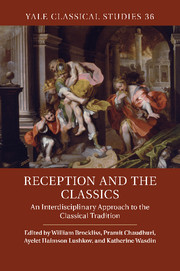Book contents
- Frontmatter
- Contents
- Notes on contributors
- Acknowledgements
- Chapter 1 Introduction
- Part I Reception between Transmission and Philology
- Chapter 2 “Arouse the dead”: Mai, Leopardi, and Cicero's commonwealth in Restoration Italy
- Chapter 3 Honor culture, praise, and Servius’ Aeneid
- Chapter 4 Joyce and modernist Latinity
- Chapter 5 Lyricus vates: musical settings of Horace's Odes
- Part II Reception as Self-Fashioning
- Part III Envoi
- Bibliography
- Index
Chapter 3 - Honor culture, praise, and Servius’ Aeneid
from Part I - Reception between Transmission and Philology
Published online by Cambridge University Press: 05 December 2011
- Frontmatter
- Contents
- Notes on contributors
- Acknowledgements
- Chapter 1 Introduction
- Part I Reception between Transmission and Philology
- Chapter 2 “Arouse the dead”: Mai, Leopardi, and Cicero's commonwealth in Restoration Italy
- Chapter 3 Honor culture, praise, and Servius’ Aeneid
- Chapter 4 Joyce and modernist Latinity
- Chapter 5 Lyricus vates: musical settings of Horace's Odes
- Part II Reception as Self-Fashioning
- Part III Envoi
- Bibliography
- Index
Summary
One night in the early 1920s a musician in Paris was startled awake by the sound of pounding at his hotel room door. Going to open it, he found a heavily built man holding a smallish dog. The man was the musician Sidney Bechet, who had heard that the room's occupant was bragging around town that his dog was the “most dog” – that is, the meanest dog there was. Since Bechet believed his dog to be the most dog, he took the other man's boast to be a slur upon his animal and so, by an obvious extension, a slur upon himself. He intended to settle the matter there and then.
Bechet is remembered today as a genius of the soprano saxophone. A slightly older contemporary of Louis Armstrong, born and raised in the Creole culture of New Orleans, he is just about the only jazz musician of the period who is generally held to have been Armstrong's peer in the richness of his tone and the brilliance of his improvisations. He is also remembered for being a person as difficult as his recalcitrant instrument. This reputation was earned in a series of incidents like the Parisian dog affair that caused him to be jailed or deported repeatedly in his mostly expatriate career: the series reached a climax of sorts in 1929 when he was jailed in Paris for 15 months, and then deported, for wounding three people in a duel he fought with a banjo-player after they disagreed over a song's harmonic structure.
- Type
- Chapter
- Information
- Reception and the ClassicsAn Interdisciplinary Approach to the Classical Tradition, pp. 45 - 56Publisher: Cambridge University PressPrint publication year: 2011
- 1
- Cited by



